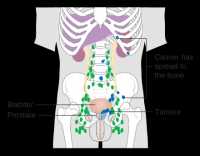Author Interviews, Gastrointestinal Disease, Gluten, Microbiome, Nature / 17.11.2018
Can a Low-Gluten Diet Improve Your Health (even if you don’t have celiac disease)?
MedicalResearch.com Interview with:
Professor Oluf Pedersen
Novo Nordisk Foundation Center for Basic Metabolic Research
University of Copenhagen
MedicalResearch.com: What is the background for this study?
Response: We focused our study on healthy people due to the world-wide bottom-up movement among healthy adults to live gluten-free or on a low-gluten diet.
Therefore, we undertook a randomised, controlled, cross-over trial involving 60 middle-aged healthy Danish adults with two eight week interventions comparing a low-gluten diet (2 g gluten per day) and a high-gluten diet (18 g gluten per day), separated by a washout period of at least six weeks with habitual diet (12 g gluten per day).
The two diets were balanced in number of calories and nutrients including the same total amount of dietary fibres. However, the composition of fibres differed markedly between the two diets.
When the low-gluten trend started years back the trend was without any scientific evidence for health benefits. Now we bring pieces of evidence that a low-gluten diet in healthy people may be related to improved intestinal wellbeing due to changes in the intestinal microbiota which to our surprise is NOT induced by gluten itself but by the concomitant change in the type of dietary fibres linked to a low-gluten intake.
(more…)







 Eliane Abou-Jaoude, MD
Allergy and Immunology Fellow
Henry Ford Health System
Detroit, Michigan
MedicalResearch.com: What is the background for this study?
Response: Early life exposure to diverse types of microbes is necessary for healthy immune development and may impact the risk for developing allergic disorders.
Theoretically the transfer of parental microbes to their offspring during infancy can influence a child’s developing gut microbiome and subsequent immune response patterns.
We wished to investigate whether parental pacifier cleaning methods, reported at 6-months of age, were associated with altered serum IgE trajectory over the first 18 months of life.
Eliane Abou-Jaoude, MD
Allergy and Immunology Fellow
Henry Ford Health System
Detroit, Michigan
MedicalResearch.com: What is the background for this study?
Response: Early life exposure to diverse types of microbes is necessary for healthy immune development and may impact the risk for developing allergic disorders.
Theoretically the transfer of parental microbes to their offspring during infancy can influence a child’s developing gut microbiome and subsequent immune response patterns.
We wished to investigate whether parental pacifier cleaning methods, reported at 6-months of age, were associated with altered serum IgE trajectory over the first 18 months of life.


















 Cara Tannenbaum, MD, MSc
Director | Directrice
Canadian Deprescribing Network
MedicalResearch.com: What is the background for this study? What are the main findings?
Response: The D-Prescribe trial was driven by the need to show that seniors can cut down on their medication in a safe and effective manner. Pharmacists intervened in a proactive way to flag patients who were on potentially risky meds such as sleeping pills, NSAIDs and glyburide and to inform them of the risks, using an educational brochure. Pharmacists also communicated with their physician using an evidence-based pharmaceutical opinion to spark conversations about deprescribing. As a result, 43% of patients succeeded in discontinuing at least one medication over the next 6 months.
Cara Tannenbaum, MD, MSc
Director | Directrice
Canadian Deprescribing Network
MedicalResearch.com: What is the background for this study? What are the main findings?
Response: The D-Prescribe trial was driven by the need to show that seniors can cut down on their medication in a safe and effective manner. Pharmacists intervened in a proactive way to flag patients who were on potentially risky meds such as sleeping pills, NSAIDs and glyburide and to inform them of the risks, using an educational brochure. Pharmacists also communicated with their physician using an evidence-based pharmaceutical opinion to spark conversations about deprescribing. As a result, 43% of patients succeeded in discontinuing at least one medication over the next 6 months.

 Yingxi (Cimo) Chen, MD, MPH, PhD
Postdoctoral Fellow
Radiation Epidemiology Branch, DCEG, NCI, NIH
Rockville MD 20850
MedicalResearch.com: What is the background for this study?
Response: Death rates from drug overdose have more than doubled in the US in the 21st century. Similar increases in drug overdose deaths have been reported in other high-income countries but few studies have compared rates across countries.
Yingxi (Cimo) Chen, MD, MPH, PhD
Postdoctoral Fellow
Radiation Epidemiology Branch, DCEG, NCI, NIH
Rockville MD 20850
MedicalResearch.com: What is the background for this study?
Response: Death rates from drug overdose have more than doubled in the US in the 21st century. Similar increases in drug overdose deaths have been reported in other high-income countries but few studies have compared rates across countries. 


